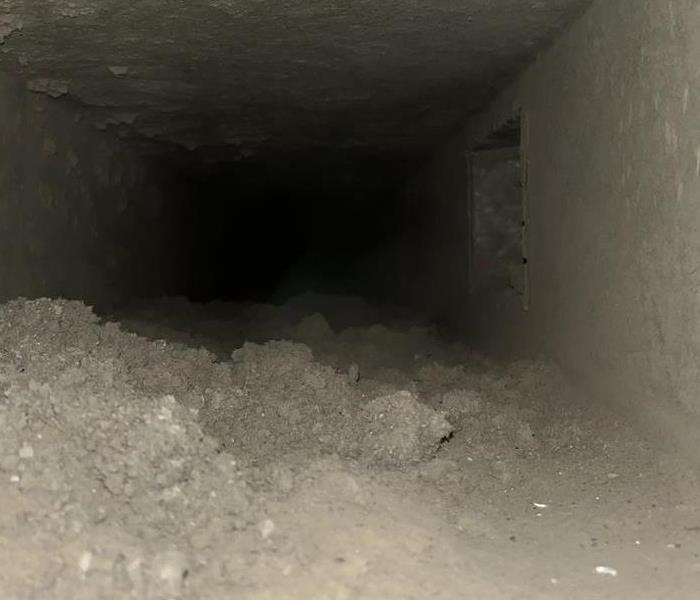Mold in Insulation: Causes, Prevention, and Effective Remediation Techniques
11/6/2024 (Permalink)
Mold growth is a common issue in many parts of a home, but one area often overlooked is the insulation. Mold can thrive in insulation, creating problems that not only affect the integrity of the building but can also result in costly repairs. Understanding how mold gets into insulation and knowing how to properly address it is essential for homeowners and property managers.
In this blog, we’ll explore the causes of mold in insulation, ways to prevent it, and effective remediation techniques to ensure your home stays mold-free.
Causes of Mold in Insulation
Mold requires two main elements to grow: moisture and organic material. Unfortunately, insulation, particularly types like fiberglass, cellulose, and spray foam, can trap moisture if conditions allow. Here are some common causes of mold growth in insulation:
1. Water Intrusion
Leaks from roofs, windows, or plumbing are one of the most common ways moisture gets trapped in insulation. When water enters the building envelope, it can soak into the insulation materials, providing the perfect environment for mold to grow.
2. Condensation
In areas with poor ventilation or temperature imbalances, condensation can occur. Warm air coming into contact with cool surfaces like walls or ceilings can create moisture, which then gets absorbed by the insulation. This is particularly common in attics, basements, and crawl spaces.
3. Poor Ventilation
Without proper airflow, humidity levels can rise, especially in areas like attics, basements, and around windows. When moisture-laden air doesn’t escape, it can settle into insulation, leading to mold growth.
4. Flooding or Storm Damage
Insulation in areas prone to flooding or heavy rain can absorb large amounts of water. Even after the floodwaters recede or the storm passes, the moisture trapped in the insulation can remain for a long time, encouraging mold growth.
5. High Humidity
Homes in regions with high humidity are more susceptible to mold growth in insulation. Inadequate dehumidification in areas like basements or crawl spaces can lead to mold infestations over time.
Remediation Techniques for Mold in Insulation
Once mold is detected in insulation, it’s important to act quickly to remove it and prevent further spread. Mold remediation in insulation can be challenging but can be done effectively with the right approach.
1. Inspection and Assessment
Before any work is done, it’s crucial to inspect the area to determine the extent of the mold problem. Professionals can use specialized equipment, such as moisture meters and infrared cameras, to locate moisture and identify affected areas. This ensures that all areas with mold are addressed, not just visible spots.
2. Removing Moldy Insulation
If the insulation is infested with mold, it usually needs to be removed completely. Simply cleaning the surface won’t be enough, as insulation often holds onto mold spores. Depending on the type of insulation, removal can involve:
- Fiberglass Batts: These are easier to remove and replace since they come in rolls or pre-cut pieces. Moldy batts should be carefully removed and discarded, and new batts should be installed once the area is dry and treated.
- Blown-In Cellulose: This requires professional equipment to vacuum out the affected insulation. After removal, it’s important to thoroughly dry and disinfect the area before re-installing new insulation.
- Spray Foam Insulation: Mold in spray foam insulation is less common, but if present, sections of the foam may need to be cut out and replaced.
3. Addressing the Source of Moisture
To prevent mold from returning, it’s critical to eliminate the moisture source. This could involve repairing roof leaks, improving drainage, installing vapor barriers, or fixing plumbing issues. Ensuring proper ventilation and dehumidification can also help maintain a dry environment.
4. Cleaning and Treating the Area
Once the insulation is removed, it’s important to clean and treat the affected area to kill any remaining mold spores. Professional mold remediation teams use specialized antimicrobial treatments to sanitize the area. This step ensures that mold doesn’t return once new insulation is installed.
5. Drying the Space
Before installing new insulation, the area must be thoroughly dried. Industrial air movers, dehumidifiers, and fans may be used to ensure that all moisture is removed from the space.
6. Reinstallation of Insulation
Once the affected area is dry and treated, new insulation can be installed. It’s important to use mold-resistant insulation materials where possible, especially in areas prone to moisture, such as basements or attics. Products like closed-cell spray foam or mold-resistant fiberglass are good options.
SERVPRO®: Your Mold Remediation Partner
If you suspect or discover mold in your insulation, professional remediation is key to preventing further damage. SERVPRO of Germantown/ Collierville specializes in mold remediation, offering comprehensive services to remove mold, clean affected areas, and restore your insulation. From inspection to full remediation, SERVPRO ensures that your home or property is mold-free and protected against future growth.





 24/7 Emergency Service
24/7 Emergency Service
